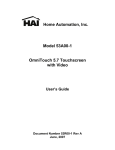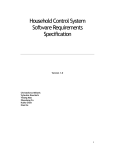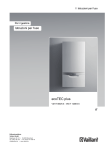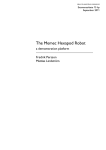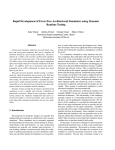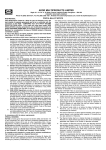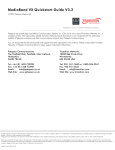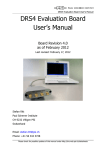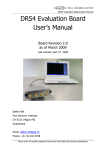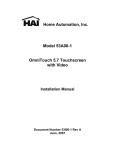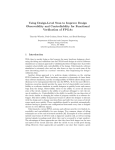Download BEEKeeper: Remote Management and Debugging of Large Scale
Transcript
BEEKeeper: Remote Management and Debugging of Large Scale FPGA Arrays Terry Filiba, Navtej Sadhal May 14, 2007 Abstract but scaling past this level is hindered by the serial nature of the protocol. The Research Accelerator for Multiple Processors (RAMP) project leverages the low cost of field programmable gate arrays (FPGAs) to build large, but cheap systems. The project provides a multi-FPGA platform for the emulation of multicore or multiprocessor systems. Large systems, such as RAMP, struggle with the scalability of JTAG; in an 8 or 16 board system, switching between boards being accessed via JTAG requires manual connection of the target board to the server running the debug software. The Center for Astronomy Signal Processing and Electronics Research (CASPER) also builds large scale processors out of many FPGA boards. These processors need to be deployed at antennas, but once deployed cannot easily be debugged remotely.[7] We propose a solution to the problem of managing and debugging the large array of Berkeley Emulation Engine 2 (BEE2) FPGA boards which are part of the Research Accelerator for Multiple Processors (RAMP) project. Currently, communicating with individual FPGAs on a specific board in the cluster for programming or onchip debugging purposes requires physical access to the device and the connection of a specialized communication cable to a host machine. We have designed and implemented a solution using a soft core on a small FPGA which connects directly to a BEE2 board in the place of the host computer. The host computer can then connect to the small unit, the BEEKeeper, over standard TCP/IP and Ethernet. This allows the host computer to manage many BEE2 boards siWe propose a system called BEEKeeper that multaneously without physical access, as well as will provide remote and scalable JTAG capabilaggregate data from many boards. ities. Augmenting the current communication system to use Ethernet rather than parallel connections will improve both scalability and acces1 Introduction sibility. In Section 2, we describe the motivation for deThe JTAG protocol has long been a valuable tool for chip developers and programmers. For board signing this system and projects that can make level debugging, JTAG chains provide a conve- use of the tool. Section 3 describes other tools for nient way to connect to a small number of chips, remotely debugging FPGAs and debugging large 1 in RAMP also arise in developing CASPER instruments. Further problems arise when these instruments are deployed on site. When something goes wrong on a board and can’t be reproduced on a lab bench someone must travel to the antenna to debug the problem.[5] systems in general. Sections 4 and 5 explain the design of the system and how much latency is introduced. Section 6 proposes a new interface that makes use of the capability to simultaneously connect to multiple boards. Section 7 provides future plans to improve the analysis and design of the system. Section 8 describes what we have learned from building this system. 3 2 Related Work ChipScopeTM Pro provides a platform for debugging and programming Xilinx FPGAs over JTAG. It provides some remote connection capability but this capability doesn’t scale well. A client computer can connect to a server in the lab that is also running ChipScope. That server must be connected via a cable to the board. Since the number of boards that can be connected to a single server doesn’t scale up well this doesn’t provide a sufficient solution for RAMP or CASPER.[6] The architects of the RAMP project have explored various debugging strategies with respect to processor interaction and logging. Some of this functionality is planned in the RAMP design framework, but much of it is dependent upon the system avoiding total failure [7]. As we attempt to give the designer complete accessibility to onchip signals and programming, our addition to the RAMP debugging framework should provide additional power in such scenarios. There have also been other efforts at managed debugging of large-scale systems from a software standpoint. Notably, Fowler, LeBlanc, and Mellor-Crummey of the University of Rochester propose an integrated system for debugging parallel programs running on shared-memory multiprocessors [4]. They explore a methodology for analyzing parallel programs and then develop a framework for debugging these programs on an Background The design of the Berkeley Emulation Engine 2 (BEE2) board at the Berkeley Wireless Research Center (BWRC) has created a useful platform for many research projects. This board provides a large amount I/O and processing power that is utilized in many multiprocessing applications. There are four Xilinx Virtex II Pro 70 FPGAs on the board used for processing and linked by a single JTAG chain. An additional Virtex II Pro 70 is on the board on a separate JTAG chain and is primarily used to control the other four FPGAs.[3] The RAMP project uses the BEE2 boards for emulation. Currently the prototype system is using 8 BEE2s boards but in order to work with systems that have thousands of cores the number of boards will need to scale greatly. The demands of this scaling will put a great strain on the current system of debugging.[7] The CASPER group develops radio astronomy tools for phased antenna arrays. Large numbers of small antennas provide a cheap alternative to building a single large antenna, but require a lot of back-end processing to combine the data from the different antennas. These tools, such as beam formers and correlators, scale in size based on the number of the antennas in the array. The difficulties of scaling that are experienced 2 Chipscope WinDriver Parallel Port Parallel Cable Parallel to JTAG JTAG Cable BEE2 Client Computer Figure 1: Initial debugging architecture. The client computer is connected via a parallel cable to the BEE2. Components in purple (Parallel to JTAG adapter, Parallel Port, and the portion of WinDriver that interfaces with the Parallel Port) will need to be removed in order to improve scalability and remote connection capability. municating over a parallel cable. Finally, the JTAG cable is connected to the BEE2 board. A typical machine only has a few parallel cable ports. To use the remote debugging tools provided by ChipScope there would need to be a server for every few boards. In order to provide scalability, the parallel cable will be removed and replaced with an Ethernet cable. Referring to Figure 1, the components in purple must be removed. Removing the parallel cable makes the parallel to JTAG converter unnecessary. Then, since ChipScope can no longer communicate over the parallel port on the computer, part of the driver must be modified. The interface from ChipScope to the driver remains the same, but instead sending data over the parallel port it will packetize the data and send using TCP/IP over Ethernet. Figure 2 shows how the BEEKeeper system is designed. The WinDriver is modified to interface with an Ethernet port rather than a parallel port. Then, the Ethernet cable can be connected to a router and send data over the internet to the BEEKeeper board. The BEEKeeper board depacketizes the data and sends it out over a JTAG header. This is a client-server model in which the com- SMP machine. This includes monitoring each processor and keeping replay data and execution histories to be made available to an engineer at a single workstation. There are notable developments in the user interface, including scripting capabilities. While hardware and software debugging differ in many respects, the system developed by Fowler et. al. provides welcome inspiration to the problem of debugging large FPGA arrays. 4 System Architecture The current method of debugging or programming a BEE2 via ChipScope is described in Figure 1. The client computer runs ChipScope which provides a graphical interface to the user. ChipScope communicates with a kernel driver to send data over a parallel cable connected to the computer. The kernel driver is produced by a tool, WinDriver, that automatically produces source code and a makefile [2]. The parallel cable is connected to a parallel to JTAG adapter. This is a simple component that just rearranges the wires from the parallel standard to the JTAG header. There is no software in this part, and it is only necessary because the computer is com3 Chipscope WinDriver Ethernet Port Ethernet Internet Ethernet BEEKeeper Board JTAG Cable BEE2 Client Computer Figure 2: BEEKeeper debugging architecture. The parallel connection is replaced with an Ethernet cable and a small board to depacketize the data and translate it into JTAG. Components in yellow (BEEKeeper Board, Internet, Ethernet Port, and WinDriver interface to the Ethernet Port) are added to the system. vides the scalability. As long as the servers are connected to the internet, the client can connect to any of them by selecting the correct IP address. We have intercepted the functions that read and write a byte on the parallel port. Although the intercepting functions could create and send a packet, an entire packet just to send a byte of data is wasteful. Instead, we use a lazy send in which data that needs to be sent is put into a queue. The queue will get flushed in two cases. First, if the buffer to hold stored data is full then it must get flushed to ensure no data is lost due to overflow. Also, when ChipScope requests to receive data, the sent data also must be flushed. This is to ensure that the data read from the cable is resulting from the input to the chip, and is due to the fact that ChipScope blocks on reads. In order to service the requested read, the chip must be in a state assumed by software. This also implies that there can only be one outstanding read at any time. puter running ChipScope is the client and the BEEKeeper board is the server. The client is in control in this design and must initiate all communication. The BEEKeeper will be in a wait loop until the computer initiates communication. Then the client will either send or request data until it is finished and closes the connection. 4.1 Client Design The modifications on the client are all at the driver level. Because ChipScope is closed source we could only intercept the data being sent by ChipScope through the driver. The driver’s source is available and has been modified to remove the existing parallel port interface. The driver provides an interface to ChipScope that allows it to read and write data byte by byte. The data is taken and put on the parallel port using functions that immediately write to the hardware; we have altered the hardware interface of the driver to send data over an Ethernet port instead of a parallel port. Since streams of data need to be communicated through the chip, a lossy channel is not appropriate The communication is done over TCP/IP to ensure lossless communication. The client currently has a software programmed IP address. This aspect is what pro- 4.2 Packet Layout The JTAG protocol uses very few bit lines to transmit information due to the fact that everything is done serially. The lines in and out of the chip are shown in Figure 3(a). Three lines 4 TMS TDI TDO TCK GND VCC TCP/IP Packets 9 8 7 6 5 4 3 2 1 Ethernet Port (a) 9 bit JTAG Header Spartan-3 MicroBlaze Soft Core Data sent from client computer to BEEKeeper board TCP/IP Header TMS Data Divided into 8-bit pieces blank TDI Req. Data blank TCK blank blank Network Driver Standalone Server Software Data sent from BEEKeeper board to client computer blank blank blank TDO blank blank blank blank (b) BEEKeeper Packet Format JTAG Header JTAG Data Figure 3: The 9 bit JTAG pin out data in 3(a) and how it is packetized by the BEEKeeper system 3(b). Figure 4: Inside the BEEKeeper Board are used when sending data into the chip: TMS, TDI, and TCK. TCK clocks the input coming in on the other wires so the chip can determine when it is valid. TMS sets the test mode and TDI contains the test data. The only output from the chip is TDO whose validity is also determined by TCK. intermixed in a single packet to try to reduce the number of packets the client must send. Packets sent by the server only need to contain TDO. As Figure 3(b) shows, the single bit, TDO, is padded out eight bits. While this may seem inefficient and an obvious point of optimization, it turns out to be insignificant. Because the request to get data must be serviced before it returns, there can only be one request outstanding at a time, as described in Section 4.1. This means that a packet can only contain one bit of TDO. The overhead of using a single packet to send one bit far outweighs the overhead of the 7 extra bits used as padding in the data. The TCP/IP header sent along with the single bit is a much more significant amount of overhead and as described in Section 7 is a better focus for optimization. The packets constructed by the client need to contain the JTAG information TCK, TDI, and TMS. Also, it needs a way to distinguish if it is sending data or requesting to receive a packet. In a single byte, the JTAG specific data is arranged in the same order as in the JTAG header (referring to Figure 3). Where the TDO bit would normally be, there is a request data bit. If this bit is high then the other data in the byte should be ignored and the server should read data from the JTAG port. If the request data bit is low then the data should be sent to the chip. This method allows for read and write requests to be 5 4.3 Server Design to use the JTAG cable. It takes the data from the packets, 8 bits at a time, and determines whether it should send or receive data. This is determined by the request data bit as outlined in Section 4.2. One important feature of the server design is portability. The WinDriver interface with ChipScope is build into the client. This client is only useful for a board that can use ChipScope as its JTAG interface. Unlike the client software, the BEEKeeper server only relies on the packet format. Although different boards use different numbers of pins for JTAG, the definition of the JTAG header send by the BEEKeeper board can be configured with a packet as well. The server consists of an Avnet Xilinx Spartan3 Mini-Module board which is referred to as the BEEKeeper board. This board provides the I/O necessary to connect an Ethernet cable and a JTAG cable. The BEEKeeper board has an Ethernet port and 76 pins of I/O directly to the chip, far more than what is needed for a JTAG header. The board has a flash memory as well as a configurable Spartan-3 3S400 FPGA [1]. For development purposes, this board has been mounted on an Avnet Mini-Module Baseboard. The board uses the I/O pins on the Mini-Module to provide standard forms of I/O that are useful for development. There is an LCD, many LEDs and switches, RS-232, and USB connections as well as JTAG to program the Spartan-3. This allows us to monitor the I/O moving between the Ethernet connection and the JTAG and debug the BEEKeeper system. The version of the BEEKeeper that would be released will not include this board. Figure 4 shows how the BEEKeeper is programmed. A MicroBlaze soft processor core is put onto the Spartan-3. This allows us to access the I/O channels and program the server using software. The software implementation has two components, a driver to communicate with the Ethernet port and a server that processes the data sent from the client. The network driver implements the TCP/IP standard similar to the standard functions UNIX networking drivers provide. The driver provides the framework to establish a TCP connection with the client and send and receive packets. The server software waits until a client makes a connection to it and begins sending data packets. It will loop until it finds valid data to process. Then, the software must determine how 5 Results We have implemented our system as described with additional testing and data gathering portions to measure its performance and usability. The obvious result from running numerous tests is that the data transmission using the BEEKeeper is much slower than when using the parallel cable directly. This, however, is to be expected due to the additional overhead of packing up the data, transmitting it over the network, and then unpacking it again. 5.1 Testing Setup Our testing setup uses a single BEEKeeper module connected directly to a host computer through an Ethernet crossover cable. The host computer is running RedHat Linux with Linux kernel 2.6.18. The BEEKeeper is then connected directly to the target BEE2 board with a ribbon cable whose signals are visible through a logic analyzer. We collected timing data from the host 6 Figure 5: The frequency distribution of round trip times for data requests by ChipScope for a single bit from the target computer using the Linux kernel’s timing fea- reduced to 2.18MHz as measured by a logic analyzer at the connection between the BEEKeeber tures to measure actual elapsed time. and the BEE2. This slow down is due only to the time it takes the processor to unload data 5.2 Speed Measurements from its buffer, examine it for read requests, and As expected, the transmission of JTAG data over then send it out on the data line, and does not TCP/IP with our system is orders of magnitude take into account any network delays that might slower than direct access with the parallel cable. slow down data even further. The sources of this slow down include network Examining the actual flow of data through the overhead as well as the time it takes to MicroBlaze to process the incoming data and place it on whole system, we found that our clock rate was the JTAG lines. The latter is dependent on how further reduced to an average of 167kHz. This the server software on the BEEKeeper is written means that communication over our system is and results in a hard limit on the top speed at about 30 times slower than it had been over the parallel cable. This slow down can be attributed we can transmit data. When using the parallel cable directly, the to the network overhead and the lack of comclient computer sets the JTAG clock rate to pression in our data stream. An additional source of delay is the fact that 5MHz, meaning the serial communication occurs at 5Mbps. The ChipScope software uses timers only one data request by the client computer can to maintain this rate and thus not violate the be outstanding at any time. That is, every time setup or hold times of the device being accessed. the client wants to read the TDO line, it must In contrast, when our server software is running actually request the data from the server. In conon the MicroBlaze processor and transmitting trast, the parallel cable system is always sending data as fast as possible, the JTAG clock speed is the TDO data on a dedicated wire, so it is al7 access to the ChipScope code to modify the end to end interface. By rethinking the interface of the tools, we can improve debugging for large systems. Since the tool will communicate over TCP/IP, there is no longer a need for a kernel level driver. Client software is sufficient to send data over the Ethernet port. We propose an interface for debugging multiple boards and some useful applications for this design. The system should allow the user to design not only at the chip level but at the system level. Instead of specifying the IP address of a single JTAG chain, multiple chains can be added to allow for communication to different chips simultaneously. Also, it should be possible to group FPGAs together based on what they do. In may applications the same programming is put on many FGPAs. This could be done by opening connections to many addresses rather than just one. Then the data that is normally transmitted to a single FPGA is transmitted to a group of addresses. This will work as long as no errors occur, since all of the chips should stay in the same state. When errors begin to occur, one data set is no longer appropriate for all the chips. By creating a new thread to deal with the failing chip exclusively the rest of the programming is free to proceed unhindered. The new thread can retry the operation and attempt to continue normal operation. Then if the problem is unrecoverable, the system can report a list of the chips that failed. This system could also be used to monitor data running on the FPGAs. By requesting the same data on the each chip, the exact same method to program multiple FPGAs can be used to send the data requests over JTAG. Errors can be dealt with in the same way as described for programming. In this case, the output from the ways there for the client to read it. This slow down can be expressed by comparing the round trip time of a data request in our system to the execution time of a read-byte operation on the parallel port. Figure 5 shows the distribution of round trip times seen during JTAG communication. The average round trip time to get a single bit of data from the TDO line is 1.3ms, and over 90% of round trips are below 1.5ms. This time results from all of the previously described sources of delay aside from packet loss due to network congestion. On the other hand, the when reading from the parallel port, the data has already reached the local machine, so it only takes 1.8µs to read a bit and return it to the software. This discrepancy is expected because we are effectively using an entire TCP/IP packet to send one bit of data. Regardless of this significant decrease in speed, the actual effect on debugging interaction, while noticeable, should not actually impact debugging productivity except in the most extreme cases. Given that Xilinx Virtex II bitfiles are on the order of 1MB, transmitting such a file at 167kbps would take roughly one minute rather than being nearly instantaneous as with the parallel cable. 6 Proposed Debugging Interface The system we have implemented provides a way to use the existing ChipScope software in a novel way. Rather being limited by the number physical parallel ports, a computer now has access to any board in the system. Currently, the end to end system appears the same as before; ChipScope connects to a single JTAG chain to program or debug it. Unfortunately, we do not have 8 of data coming from the BEE2 board. If the debugging interface was open source, some of this could be alleviated. Since the program should know how much it wants to read from the board, it can send a request for multiple reads in a single packet or interleaved reads and writes. Then, when the BEEKeeper board sends a packet back, it can contain as much data as the program requested. Finally, we must consider that our experiments have demonstrated that the serial nature of JTAG and its chattiness make it somewhat unsuitable for network transmission. Given this, it may be desirable to develop a more advanced device than our BEEKeeper, which will actually receive bulk data in a different format and then generate the JTAG signals locally. Such a system would require understanding of the JTAG protocol as well as the development of a communications interface that supports higher level communications. In some respects, this might work like the previously described remote ChipScope ability that already exists. However, replacing the computer connected directly to the board with an embedded system significantly improves scalability and packaging by allowing said system to be integrated entirely on the board. While this might drive up costs, it is worth exploring in effort to increase the power, flexibility, and speed of the debugging system. chips also needs to be logged. It can be recorded and viewed either by focusing on a single chip or viewing the data from multiple chips that was generated at the same time. 7 Future work This work can be further explored in a number of ways. Further benchmarking would be useful, as well as some updates to improve the system. Also, it would be useful to find ways to reduce the overhead of packetizing and processing the data, either by Section 5 gives results from timing tests done in a lab to see how using the TCP/IP overhead slows down JTAG speed. These tests do not account for network effects like dropped packets or Additional tests would be useful to get an idea of how a system like this could be used across longer distances and on lossy networks. The BEEKeeper board was chosen because it is cheap and small. However, there isn’t a need for the board itself. We could integrate the necessary parts of the BEEKeeper onto the board that is being debugged. This would only require an Ethernet port, an FPGA, and a small memory to store the programming. Then, rather than having pins coming out of the board, the connection between the BEEKeeper hardware and the FPGA can be wired on the board. Integrating this hardware onto the board will create a small cost increase in the board but will ease debugging. Additionally, we would like to implement the debugging interface described in Section 6. This would give the user better control of the system as a whole as explained. Also, this could allow for optimization benefits as well. Currently, the system has to use a whole packet for a single bit 8 Conclusion We have presented and evaluated a remote and scalable system targeted to programming and debugging BEE2 boards. This is achieved by modifying the communication between ChipScope and and the JTAG interface to the board. Because ChipScope is closed source, we intercept 9 the data bound for the parallel port at the driver level and reroute the data to the computer’s Ethernet port. Using the TCP/IP standard allows the data to be transmitted through the Internet and arrive at our intermediate hardware, the BEEKeeper. The BEEKeeper is a small board that receives the packets and processes them into JTAG. This board essentially interfaces one of the BEE2 JTAG chains to the network. We did find additional latency, as expected, from migrating from a nearly lossless channel (the parallel port) to TCP/IP over Ethernet in our testing. Also, the fact that we could not modify ChipScope created additional inefficiencies. Any reads from the JTAG cable requested by ChipScope have to be serviced immediately. Because of this, we must use an entire packet just to send one bit. We believe that this reduction in speed, while significant, will have little effect on the debugging efficiency of an engineer because of the small amount of data that is actually communicated. We believe that by modifying the user interface for connecting to the chip, improvements both in debugging capability and communication latency will result. By queueing up multiple receive requests in the same packet, a single packet coming from the BEEKeeper board could be used to service all of the read requests. Aside from this, we believe there is plenty of room for future work in improving this communication link and reworking the user interface and debugging software. We have laid the groundwork for future innovations in working with large systems make necessary by projects like RAMP and CASPER. As large systems begin to build momentum, methods for the debugging of large FPGA arrays and other immensely parallel devices should mature far beyond what we have discussed here. References [1] Spartan-3 mini module user guide. Technical report, Memec, 2005. [2] WinDriver USB v9.00 User’s Manual, 2007. [3] Chen Chang, John Wawrzynek, and Robert W. Brodersen. BEE2: A high-end reconfigurable computing system. IEEE Design & Test, 22(2), 2005. [4] Robert J. Fowler, Thomas J. LeBlanc, and John M. Mellor-Crummey. An integrated approach to parallel program debugging and performance analysis onlarge-scale multiprocessors. ACM SIGPLAN Notices, 24(1), 1989. [5] Aaron Parsons, Donald Backer, Chen Chang, Daniel Chapman, Henry Chen, Patrick Crescini, Christina de Jesus, Chris Dick, Pierre Droz, David MacMahon, Kirsten Meder, Jeff Mock, Vinayak Nagpal, Borivoje Nikolic, Arash Parsa, Brian Richards, Andrew Siemion, John Wawrzynek, Dan Werthimer, and Melvyn Wright. Petaop/second FPGA signal processing for SETI and radio astronomy. Proceedings of the Asilomar Conference on Signals, Systems, and Computers., 2006. [6] Brent Przybus. Un-tethered debugging. Technical report, Xilinx, Inc., 2005. [7] John Wawrzynek, Mark Oskin, Christoforos Kozyrakis, Derek Chiou, David A. Patterson, Shih-Lien Lu, James C. Hoe, and Krste Asanovic. RAMP: A research accelerator for multiple processors. Technical report, University of California at Berkeley, 2006. 10










